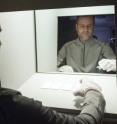Under some LED bulbs whites aren't 'whiter than white'
Related images
(click to enlarge)
For years, companies have been adding whiteners to laundry detergent, paints, plastics, paper and fabrics to make whites look "whiter than white," but now, with a switch away from incandescent and fluorescent lighting, different degrees of whites may all look the same, according to experts in lighting. "Retailers have long been concerned with the color-rendering qualities of their lighting, but less aware how light sources render white," said Kevin W. Houser, professor of architectural engineering, Penn State.
Not long ago, the only practical choices for home, office or commercial lighting were incandescent or fluorescent bulbs. More recently, compact fluorescent bulbs, which use less energy than incandescent bulbs, became popular, but compact fluorescents are not always accepted by consumers because of poor color rendition, lack of dimability, slow warm-up to full output and because they contain mercury.
The most recent popular entry into home or commercial lighting are light-emitting diode (LED) bulbs, which while currently expensive, are often even more energy-saving than compact fluorescents.
While some LED bulbs will make colors pop, the vast majority do not showcase or differentiate the appearance of white products, according to Houser, because all white light is not the same.
Different light sources contain different combinations of the wavelengths of light. A broad variety of wavelengths will create light that appears white to the human eye, but different mixtures of wavelengths will affect how colors are rendered. When it comes to seeing the color white, the light source is very important because of how product manufacturers make white products appear white using whiteners.
Whiteners contain fluorescent materials that glow under violet and ultraviolet light. Sunlight, fluorescent light and incandescent light all produce some light in the violet and ultraviolet range. The whiteners used in consumer products work under those conditions, resulting in a bright white perception.
However, most current LED bulbs use blue LEDs to excite a phosphor that then glows white, but produces no violet or ultraviolet light.
Houser, working with a Penn State student and researchers from Soraa Inc. of Fremont, Calif., asked 39 participants to observe various combinations of light sources and white objects to see how the light source affected perceptions of white. They report their results in a recent issue of Leukos, the journal of the Illuminating Engineering Society.
The participants completed three tests -- selection, forced choice and sorting -- using five different light sources -- a blue-pumped LED, filtered halogen lamp and three violet-pumped LEDs with differing levels of violet emissions.
In the sorting experiment, the researchers placed six calibrated whiteness cards of varying whiteness on a table in a booth enclosed on three sides. They asked participants to arrange the cards in order of whiteness under each of the five light sources.
Under the halogen light and violet-pumped LED lights with 7 and 11 percent violet emission, the order was correct. Two of the cards were flipped under violet-pumped LEDs with only three percent violet emissions.
"With the LED but only blue pumping the phosphors, the order became random," said Houser. "People simply couldn't tell the difference between the cards. Under the blue-pumped LED, which is notable because blue-pumped LEDs are by far the most common type for general lighting."
In the forced choice test, two nominally identical cards were placed in each of two booths containing different light sources. Participants were asked to choose the card that was whiter under all of the permutations of each of the five light sources.
"The light sources with higher violet component permitted the best discrimination between the targets," said Houser.
In the selection test, researchers asked the participants to look at a reference card in one booth and rank the cards in a second booth as either as white or whiter than the reference card. Again the blue-pumped LEDs did not fare well.
The researchers note that "engineering of an LED source's spectrum is necessary for an accurate rendering of whiteness."
Source: Penn State
Other sources
- Under some LED bulbs whites aren't 'whiter than white'from Science DailySun, 20 Apr 2014, 17:31:19 UTC
- Under some LED bulbs whites aren't 'whiter than white'from PhysorgFri, 18 Apr 2014, 15:00:33 UTC


